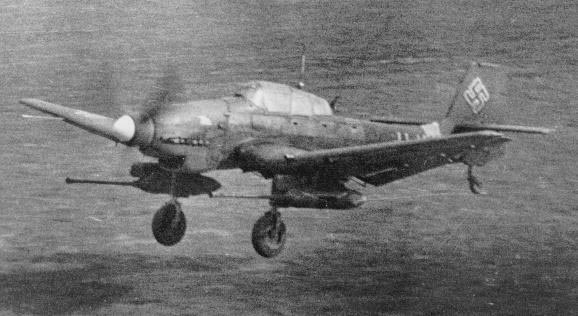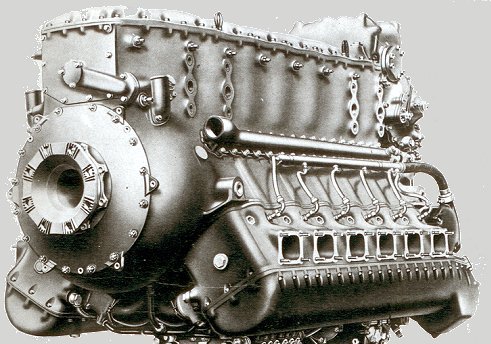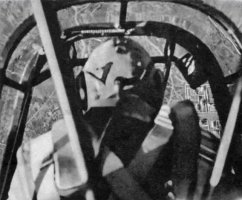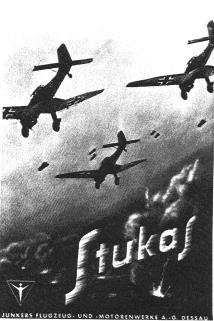Stuka JU-87

One of the best anti-tank aricraft of World
War 2
| One
of the experiences from WW1 and part of the "Blitzkrieg"
tactics, was the usage of aircraft as a highly mobile air artillery
to support troops on the ground. One mean of deliver efficient
air support with high accuracy of this kind was to utilize dive
bombing.
A dive bomber is a light bomber aircraft
that dives directly against its targets in order to provide
greater accuracy. Diving as step as possible (vertically)
at the target, striving for following the direction the bombs
will take, the aircraft will release the bombs very close
to the target (low level) at high speed. This more or less
circumvents all of the major effects of drag and gravity which
allows a dive bomber to accurately place bombs on small targets
with relative ease. Additionally, no complicated precision
gear (like the Norden bombsight) is needed. Since the dive
bomber had a tremendeuos ability to deliver highly accurate
fire. Dive bombers were preferably used to attack high value
targets such as strong defensive positions, bunkers, ships,
bridges, etc. |
In the late 1920s and early 1930s, Germany
became influenced by Sweden and USA and started to develop their
own dive bomber airplanes and tactics. In 1933 Ernst Udet witnessed
a demonstration of divebombing techniques, perfomed by US. Air
Force with F8 Curtis Hawk "Hell divers". Deeply impressed
he suggested that Germany should implement this in the Luftwaffe.
Göring promised Udet to buy him two Curtiss Hawks on the
condition that he joined the Nazi party. Accepting the deal,
Udet became a major proponent of the dive bomber concept, taking
credit for having introduced it to the Luftwaffe (who were already
interested in such designs but used Udet as a front). Several
models were tested and came into use, but the most memorable
outcome was the Junkers Ju-87 Stuka ("Sturzkampfflugzeug"
= eng"diving fighter airplane"). The Stuka was based
upon the Junkers K-47, and quickly became a great success...
THE STANDARD STUKA:
The Ju 87B-1 may serve as an example of a standard Stuka. It flew with a crew of 2, the pilot and a rear-gunner. The engine was an 880kW Junkers Jumo 211Da that could pull the aircraft up to 385km/h. It had an operational ceiling of 8000m and a range of only 600km. Its armament was three 7.9mm machine guns (1X MG81 in each wing for the offensive role and 1X rear for the defensive role). It could carry either 1x 500kg bomb under the body of the aircraft or 4x 50kg bombs fitted to racks either under the fusilage or under the inboard portion of the wings. A third alternative were 1x 250kg bomb and 4x 50kg bombs.
The standard Ju-87 was slow and had a limited range, making it wournable to fighter aircraft and anti-aircraft artillery. It was a surprisingly accurate bomber, and the bombs were basically controlled by the pilot until the very last moment. Usually a wing of 30 Stukas would attack a target in 10 groups of three planes. The common practice of a pilot was to begin his dive at 15,000ft at an angle of 60-90°, turn on the siren, and dive earthward at up to 600km/h (350mph). He would drop the bomb at around 2,000ft, and then immediately pull up the nose and overcome a force of 4G to resume level flight.
In adition to it´s weaponry the Stuka sometimes were equiped with wind-powered siréns on the wheel covers that made a terrible and frightening noice during the dive. Nicknamed "Trumpets of Jericho" - the sirén was probably the brainchild of Udet. The bombs were also sometimes equpied with whistles. The sirén and the whistles worked as an psychological weapon and imposed fear upon the enemy soldiers under attack.
From 1942 the Ju-87G-1 was developed to act as an anti-tank
aircraft mainly on the eastern front. It was fitted with a 1400hp
Junkers Jumo 211J engine. It had a maximum speed of 314km/h,
a ceiling of 8000m and a very limited range of only 320km. The
reduced speed and range was due to the armour plating installed
to protect the pilot and gunner when flying low-level tank busting
missions. It was armed with two [Flak-18 37mm cannons] in pods
under the wings and a 7.92mm machine gun in the back for the
gunner

|
The Jumo 211 was an inverted
V-12 aircraft engine, Junkers Motoren's primary aircraft
engine of World War II. It was the direct competitor
to the famous Daimler-Benz DB 601 and closely paralleled
its development. While the Daimler-Benz engine was
mostly used in fighters and destroyers, the Jumo engine
was primarily used in bombers such as Junker's own
Ju 88 and Ju 87
|
.Total production of the 211 series amounted
to 68,248 engines with a production peak of 1700 engines per
month in the autumn of 1942.
he Germans had relized that the dive bombing technique would allow a much smaller Luftwaffe to operate effectively in the tactical and ground support role, falling well within their idea of how to use a bomber aircraft. It was noted that air supperiority was vital for the success, so the first attacks were directed against runways, anti-aircraft artillery, etc. When air superiority was obtained the Stuka was deployed before the ground forces attack, operating from small frontline airfields, giving the advancing army a flexible responsive tool against the enemy forces. The Stukas assaulted known defensive strong points and key targets, clearing the way and soften up the line for the benefit of panzer and infantry units. By strafes and precision bombing the Stukas would attack targets such as:
* troop concentrations
* communication centers
* fuel dumps
* ammunition dumps
* supply lines
* roads - cutting them of
This requiered a close cooperation between the ground forces and the Stukas. Through special ground to air coordinators ("Stukaleiters" - eng = "Stuka controller") - the panzer commanders could radio the Stukas to destroy any unexpected opposition or put down pinpoint precision bombing against an enemy position - very close to the own troops. The tight and smooth cooperation and communication between army and Luftwaffe commanders were the key elements in the successful campaign in 1940. Today we call this for Close Air Support (or Tactical Strike Support) and the aircraft are coordinated by a [Forward Air Controler - FAC].
The crossing at Meuse - 13th of May 1940, may serve as an example of tactics utilising the Stuka:
* 120 Stukas were devided into three sections (40 airplanes/section).
* At 7:00 hours Do-17 medium bombers attacked the defensive positions, followed by artillery fire observed from a "Fieseler Storch" artillery reconaissannce aircraft that was covered/escorted by a fighter support consisting of 80x "Me Bf-109s".
* At 12:00 hours the first section with Stukas attacked in waves of 2-3 airplanes at the time.
* The 2:nd section at an altitude of 12.000 feet looking for missed targets and attacking them.
* The 3:rd section operated isolated from the other two sections, picking out single and moving targets.
* At 15:00 hours, Do-17s and Ju-87s under protection from fighters, performed coordinated attacks together with artillery.
|

|
|
Stuka dive bombing target
|
PRE-DIVE CHECKLIST:
1. Landing flaps at cruise position.
2. Elevator trim at cruise position.
3. Rudder trim at cruise position.
4. Aircrew pitch set at cruise.
5. Contact altimeter on.
6. Contact altimeter set to release height.
7. Supercharger set to automatic.
8. Throttle pulled right back.
9. Cooler flaps closed.
10. Dive brakes opened.
THE DIVE SEQUENCE:
1. The pilot finds his target and
begins diving. Dive brakes open, this automatically noses
the aircraft over into a dive. Red tabs protrude from the
upper surfaces of the wing as a visual indicator to the
pilot : at the same time the automatic dive recovery system
is actuated. The pilot aims the entire aircraft at his target
using a simple gun-type sight (a marker on the canopy that
he aligns with the target).
2. The Stuka dives at an angle between
60-90 degrees and accelerates to 600km/h (350mph). It would
hold this speed with the help of the dive-brakes located
on the wing, but this inevitably puts a lot of stress on
the structure.
3. When the aircraft is reasonably
close to the target, a light on the contact altimeter comes
on to indicate the bomb-release point-usually at a minimum
hight of 450m. The pilot releases the bomb by depressing
a knob on the control column to release weapons and to initiate
the automatic pull-out mechanism. A clutch located under
the fuselage would swing the bomb out of the way of the
propellor, and it also starts pulling the plane up automatically
incase the pilot have become unconscious.
4. When the bombs leave the cradl
ethe pullout mechanism is activated and the airplane automatically
initiates a 6g pullout, returning elevator trim tabs to
normal position. Can be overridden by the pilot in emergency.
Once nose is above horizon, dive brakes retract, throttle
opens and air screw is set to climb. The pilot regains consciousness
and control, and resumes normal flight. He use his remaining
bombs under the wings for other targets.

|
Specifications
| |
| |
Ju
87A |
Ju
87B |
Ju
87D |
Ju
87G |
| |
| Production |
1936-1938 |
1938-1941 |
1941-1944 |
refitted Ju 87D |
| Role |
ground attack |
ground attack |
ground attack |
anti-tank |
| Length |
10.8 m |
11.1 m |
11.1 m |
11.1 m |
| Wingspan |
13.8 m |
13.8 m |
13.8 m |
13.8 m |
| Height |
3.9 m |
3.9 m |
3.9 m |
3.9 m |
| Wing area |
31.90 m˛ |
31.90 m˛ |
31.90 m˛ |
31.90 m˛ |
| Empty weight |
2273 kg |
2760 kg |
2810 kg |
3600 kg |
| Maximum weight |
3324 kg |
4400 kg |
5720 kg |
5100 kg |
| |
| Engine |
Junkers Jumo 210D |
Junkers Jumo 211Da |
Junkers Jumo 211J |
Junkers Jumo 211J |
| Maximum Power |
720 hp |
1200 hp |
1410 hp |
1410 hp |
| Maximum Power |
530 kW |
883 kW |
1037 kW |
1037 kW |
| Maximum speed |
310 km/h |
383 km/h |
408 km/h |
375 km/h |
| Dive speed |
550 km/h |
600 km/h |
600 km/h |
| Range with bombs |
800 km |
600 km |
1165 km |
1000 km |
| |
| Ceiling |
9430 m |
8100 m |
9000 m |
7500 m |
| Climb |
|
3000 m in 8.8 min |
3000 m in 14 min |
3000 m in 13.6 min |
| Forward guns |
1×7.92 mm MG
17 |
2×7.92 mm MG
17 |
2×7.92 mm MG
17 |
2×7.92 mm MG
17
2×37 mm BK 37 |
| Rear guns |
1×7.92 mm MG
15 |
1×7.92 mm MG
15 |
1×7.92 mm MG 81Z
(twin MG 81) |
1×7.92 mm MG 81Z
(twin MG 81) |
| Maximum bombs |
250 kg |
500 kg |
1800 kg |
none |
| Typical bombs |
1×250 kg |
1×250 kg
+ 4×50 kg |
1×500/1000 kg
+ 4×50 kg |
none |
 |
The most famous Stuka ace must be Hans
Ulrich Rudel that usually flew the Junkers Ju-87G-2 "Kanonenvogel".
Rudel flew 2530 combat missions, and was granted almost no
leave throughout his four years of active duty.
 He
was shot down 32 times with and many aircraft were brought
back to base that were later written off, due to heavy combat
damage. Rudel became wounded on many occasions, including
the partial amputation of his right leg in the Spring of 1945,
after which he continued to fly with a prosthetic limb. His
most famous achivement occured in March 44. Rudel had landed
behind Soviet lines to retrieve a downed German aircrew, but
snow and mud bogged down the airplane - making it impossible
to take off. Approaching Soviet troops forced them, to set
the aircraft on fire and flee on foot. Barring their escape
was the wide river of "Dnjestr". The Germans stripped
to their longjohns, and swam across the ice-clogged river.
Rudel's close friend and crewman, Erwin Henstchel, drowned
a few meters from the far shore. He
was shot down 32 times with and many aircraft were brought
back to base that were later written off, due to heavy combat
damage. Rudel became wounded on many occasions, including
the partial amputation of his right leg in the Spring of 1945,
after which he continued to fly with a prosthetic limb. His
most famous achivement occured in March 44. Rudel had landed
behind Soviet lines to retrieve a downed German aircrew, but
snow and mud bogged down the airplane - making it impossible
to take off. Approaching Soviet troops forced them, to set
the aircraft on fire and flee on foot. Barring their escape
was the wide river of "Dnjestr". The Germans stripped
to their longjohns, and swam across the ice-clogged river.
Rudel's close friend and crewman, Erwin Henstchel, drowned
a few meters from the far shore.
Rudel continued and were pursued by
hundreds of Soviet troops, all intent on collecting the 100
000 ruble bounty which Stalin himself had placed on his head.
During the escape Rudel became hit in the shoulder by a bullet
as the Soviet soldiers chased him with dogs and from horsebacks.
Through incredible ingenuity, audacity, and raw determination,
Rudel escaped and made his way, alone but alive, back home,
despite being more than 30 miles behind Soviet lines when
he began his 24 hour trek. He was barefoot and almost naked
in the sub-freezing winter weather, without food, compass,
or medical attention.
All of Rudel's personal victories as
a ground-attack pilot were achieved exclusively against the
Soviets, operating under primitive condition. His confirmed
victories (those witnessed by two or more fellow pilots) include:
518+ Tanks, 700 Trucks, 150+ Flak and Artillery positions,
9 Fighter/Ground Attack Aircrafts, the battleship "October
Revolution", the cruiser "Marat" (in the harbour
at Kronstadt), 70 landing crafts, and additional hundreds
of bridges, railway lines, bunkers, etc. He also led the attack
against the destroyers Kelly and Kashmir which resulted in
their sinking (the 23 May 1941 south of Krete).
The 1st of January, 1945 Rudel was
rewarded with the "Knight's Cross with Golden Oakleaves,
Swords & Diamonds". Note that the Golden Oakleaves
were awarded once during the entire war.
King Tiger Tank
Hetzers
Marder
Panzerjager
Anti-Tank
Artillery [German]
Contact Webmaster
Mike Kaspar
|
|

